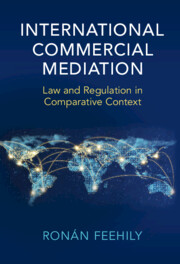Book contents
- International Commercial Mediation
- International Commercial Mediation
- Copyright page
- Dedication
- Contents
- Preface
- Foreword
- Cases
- Statutes
- International Conventions, Laws, Codes and Rules
- 1 Introduction to Commercial Mediation
- 2 Commercial Mediation in the International Context
- 3 Agreements for Future Mediation
- 4 Approaches to Mediation
- 5 Mediators and Their Appointment
- 6 Lawyers and Other Professional Mediation Supporters
- 7 Conduct and Costs
- 8 Mediated Settlement Agreements
- 9 Confidentiality
- 10 Process Controversies
- Bibliography
- Index
2 - Commercial Mediation in the International Context
Published online by Cambridge University Press: 01 September 2022
- International Commercial Mediation
- International Commercial Mediation
- Copyright page
- Dedication
- Contents
- Preface
- Foreword
- Cases
- Statutes
- International Conventions, Laws, Codes and Rules
- 1 Introduction to Commercial Mediation
- 2 Commercial Mediation in the International Context
- 3 Agreements for Future Mediation
- 4 Approaches to Mediation
- 5 Mediators and Their Appointment
- 6 Lawyers and Other Professional Mediation Supporters
- 7 Conduct and Costs
- 8 Mediated Settlement Agreements
- 9 Confidentiality
- 10 Process Controversies
- Bibliography
- Index
Summary
Mediation is neither novel nor new. However, traditional forms of mediation are different from modern mediation practice; in traditional forms, the role and social standing of the mediator are central to the process, and the outcome focuses more on social harmony than on the individual rights or interests of the parties. This difference has given rise to two broad mediation cultures. Cultural differences can be reflected in different approaches to meeting needs, and can shape the interests of the parties and party behaviour during the process. As an informal and adaptable process, mediation offers the possibility of greater sensitivity to cultural differences. A consequence of globalisation has been the increasing harmonisation of laws and practices, and the harmonisation of dispute resolution systems is an important part of this movement. This is reflected in the emergence of several regional and international instruments, the most recent of which is the Singapore Convention. What matters is the potential for any new regional or international legal instrument to be effective and have a positive impact on the people and corporations involved in cross-border legal relationships.
Keywords
- Type
- Chapter
- Information
- International Commercial MediationLaw and Regulation in Comparative Context, pp. 29 - 52Publisher: Cambridge University PressPrint publication year: 2022

